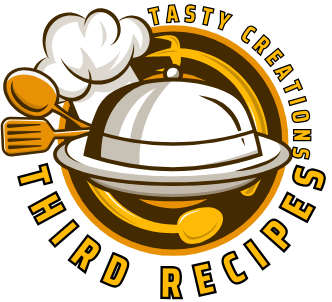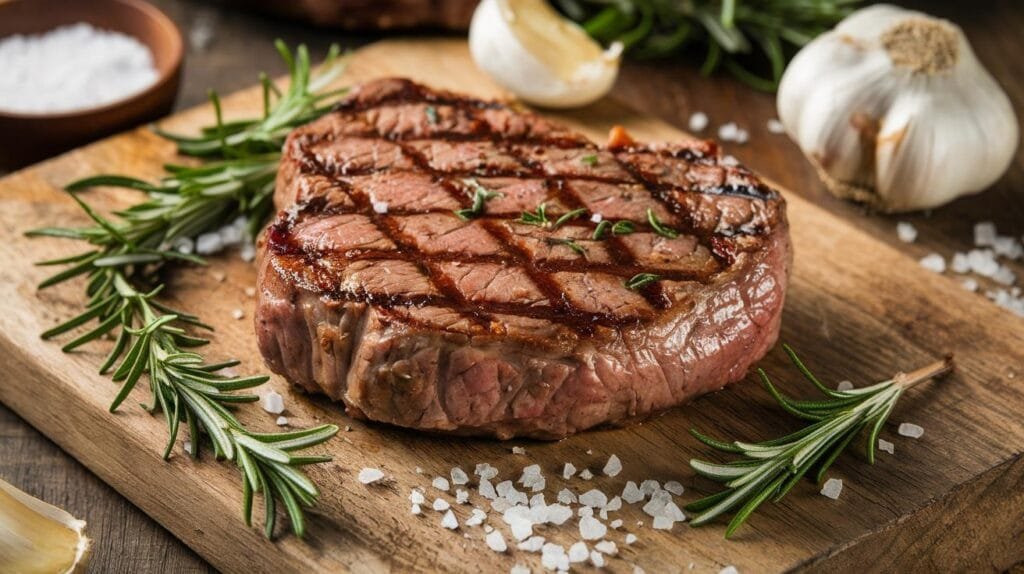Cooking the perfect cowboy steak isn’t just a culinary task—it’s an experience. With its impressive size, bold flavor, and rustic charm, the cowboy steak is a feast for the eyes and the taste buds. Whether you’re new to this iconic cut of beef or looking to refine your grilling game, this article has everything you need to know. Let’s dive into the world of cowboy steaks and uncover why this cut has become a favorite for steak enthusiasts worldwide.
What Is a Cowboy Steak?
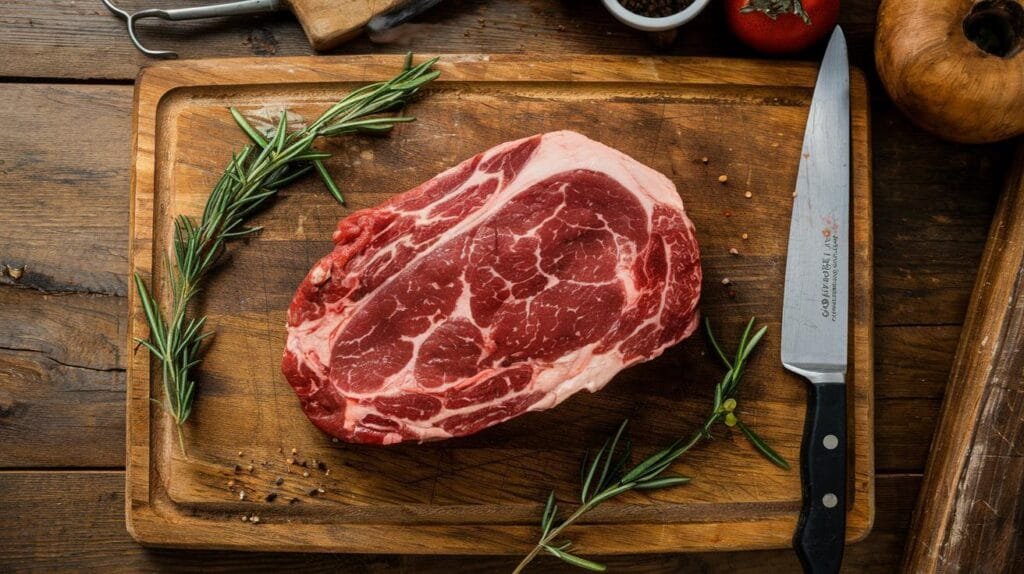
At first glance, the cowboy steak is hard to miss. This massive, bone-in cut, often referred to as a bone-in ribeye, stands out for its marbling and flavor. Marbling ensures tenderness and delivers that melt-in-your-mouth experience every steak enthusiast craves. For those who enjoy a hearty meal, consider pairing the steak with sides like Yukon Gold Potatoes, known for their buttery flavor and creamy texture, to create a perfect balance of richness.
The cowboy steak stands out because of its marbling. That network of fat running through the beef? That’s where the magic happens. Marbling ensures tenderness and delivers that melt-in-your-mouth experience every steak lover craves. Plus, the bone adds extra flavor as it cooks, enhancing the overall taste. Think of it as the ultimate steak for anyone who loves a juicy, flavorful bite.
Cowboy Steak vs Ribeye: What’s the Difference?
The cowboy steak is technically a ribeye, but it distinguishes itself with its thick cut and bone-in presentation. While boneless ribeye steaks are easier to cook, the cowboy steak’s bone adds depth to its flavor. This cut is perfect for grilling or roasting and pairs beautifully with robust toppings like grated cheese, which can enhance the savory profile of the steak with minimal effort.
Another difference? The cowboy steak usually has a richer flavor thanks to that bone. When the meat cooks, the marrow from the bone releases into the steak, adding a savory depth that’s hard to replicate with a boneless ribeye. If ribeye is the everyday hero of steaks, the cowboy steak is the larger-than-life superhero.
Tomahawk vs Cowboy Steak: A Clear Comparison
You’ve likely heard of the tomahawk steak, another cut that has steak enthusiasts buzzing. So, how does it compare to the cowboy steak? The biggest difference lies in the length of the bone. A tomahawk steak features a rib bone that’s Frenched (cleaned of meat and fat) and left extra long—resembling the handle of a tomahawk axe. This gives it a striking appearance, making it perfect for special occasions.
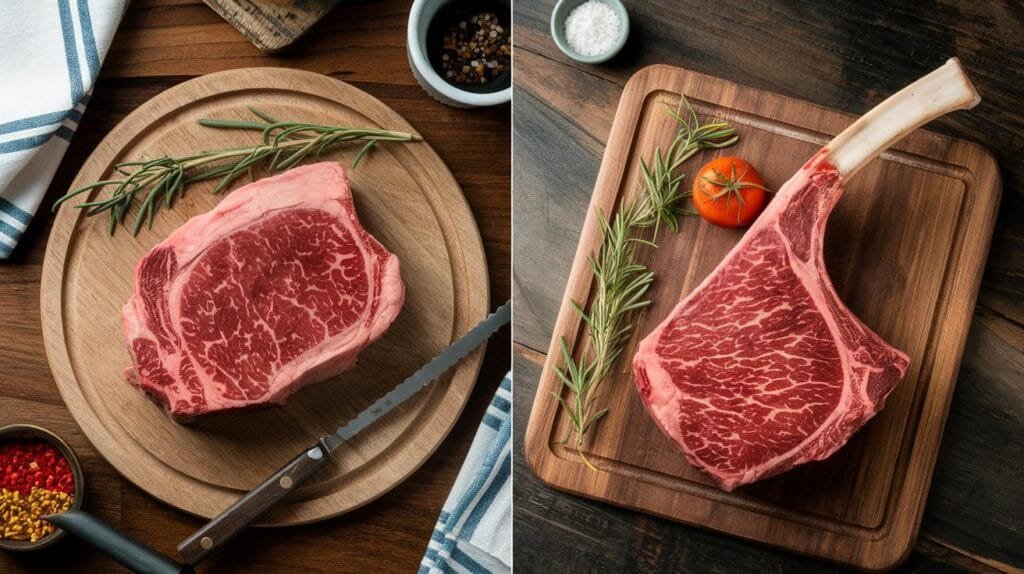
Meanwhile, the cowboy steak keeps things a bit more low-key, with a shorter rib bone that’s just as flavorful. The cowboy steak is easier to cook and handle, while the tomahawk is a visual statement. Both are delicious, but if you’re looking for practicality with a touch of rustic charm, the cowboy steak wins every time.
The History and Origins of Cowboy Steak
The cowboy steak has roots that run deep into American culinary traditions. As the name suggests, this cut was popular among cowboys in the Wild West. After long days of herding cattle, these hardworking ranchers craved a hearty, protein-packed meal. The cowboy steak, with its robust flavor and satisfying size, fit the bill perfectly.
Why Is It Called a Cowboy Steak?
The name “cowboy steak” isn’t just for show—it reflects the rugged and practical way cowboys cooked their meat over open flames, often using the bone as a handle. This rustic tradition aligns with other artisanal and flavorful foods like soppressata, a traditional Italian cured meat that celebrates bold, rich flavors. Together, they highlight how simple yet high-quality ingredients can create unforgettable culinary experiences.
Popularity of Cowboy Steaks in Modern Cuisine
Fast forward to today, and the cowboy steak has gone from campfire staple to steakhouse star. Chefs love it for its bold flavor and striking presentation, while home cooks are drawn to its versatility. Whether grilled, broiled, or roasted, the cowboy steak consistently delivers. It’s become a go-to choice for foodies who want to elevate their steak game while keeping things rooted in tradition.
Choosing the Perfect Cowboy Steak Cut
Selecting the right cowboy steak is crucial if you want the best results in the kitchen. With so many options at butcher shops and grocery stores, it’s easy to feel overwhelmed. Here’s what you need to know.
Bone-In Ribeye: The Ideal Choice for a Cowboy Steak
When shopping for a cowboy steak, look for a thick-cut bone-in ribeye. The bone should be substantial, with a good amount of meat around it. Thickness matters, too—a cowboy steak should be at least 1.5 to 2 inches thick. This ensures even cooking and maximum juiciness. The thicker the steak, the more impressive it’ll look on your plate.
How to Spot a High-Quality Cowboy Steak at the Butcher
Not all steaks are created equal. To ensure you’re getting top-quality beef, pay attention to the marbling. Look for steaks with plenty of white, fat streaks running through the meat. This marbling is a sign of tenderness and flavor. Avoid steaks with uneven coloring or excessive fat on the edges—it’s the internal marbling that counts.
Additionally, consider the source of the beef. Grass-fed and grain-finished steaks often strike a perfect balance between flavor and tenderness. If you can, opt for USDA Prime or Choice grades for the best results. And don’t hesitate to ask your butcher questions—they’re the experts, after all!
How to Cook Cowboy Steak
So, you’ve got your cowboy steak. Now what? Cooking this magnificent cut requires a bit of technique, but don’t worry—I’ve got you covered. The key is to let the natural flavor of the meat shine while achieving a perfectly seared crust and a juicy interior.
Preparing Your Cowboy Steak for Cooking
Before cooking, let your cowboy steak sit at room temperature for 30–60 minutes to ensure even cooking and maximum tenderness. Pat the steak dry, then season it generously with salt, black pepper, and garlic powder. For a complete meal, serve your steak alongside creative dishes inspired by Blackstone dinner ideas to add variety and flair to your presentation.
Pat the steak dry with paper towels to remove excess moisture—this helps create a beautiful sear. Then, season it generously. A simple mix of kosher salt, freshly cracked black pepper, and a touch of garlic powder is all you need to bring out the steak’s natural flavors.
Tips for Marinating Cowboy Steaks
While cowboy steaks are flavorful on their own, a good marinade can take them to the next level. Consider a classic marinade made with olive oil, minced garlic, rosemary, and a splash of balsamic vinegar. Let the steak marinate for at least two hours—or overnight for maximum flavor. Just remember: don’t overdo it. You want to enhance the steak’s flavor, not overpower it.
Should You Season Before or After Cooking?
There’s a lot of debate about this, but here’s the deal: season your cowboy steak before cooking. The salt helps to tenderize the meat as it cooks, creating a crust that locks in juices. If you prefer, you can sprinkle a bit of finishing salt after cooking for an extra burst of flavor.
Cowboy Steak on the Grill: Step-by-Step Guide
When it comes to cooking cowboy steak, grilling is the gold standard. The high heat of the grill creates a caramelized crust, while the smoky flavor adds depth. Here’s how to do it:
- Preheat your grill to medium-high heat. If you’re using a charcoal grill, let the coals turn white before cooking.
- Sear the steak directly over high heat for 2-3 minutes per side. This locks in the juices.
- Move the steak to indirect heat and continue cooking until it reaches your desired doneness. Use a meat thermometer to ensure accuracy—135°F for medium-rare, 145°F for medium.
- Let the steak rest for 5-10 minutes before slicing. This allows the juices to redistribute, ensuring every bite is tender and flavorful.
Charcoal vs Gas Grilling for Cowboy Steaks
Charcoal grilling delivers a smoky, authentic flavor that’s hard to beat. However, gas grills offer convenience and consistent heat. Both options work beautifully, so go with whatever you’re most comfortable using.
How to Cook Cowboy Steak in the Oven
If you don’t have a grill—or if it’s raining outside—don’t fret. You can still achieve steakhouse-quality results in your oven. Start by preheating your oven to 400°F. Meanwhile, heat a cast-iron skillet on the stove over high heat.
- Sear the steak for 2 minutes per side in the skillet.
- Transfer the skillet to the oven and roast the steak for 5-10 minutes, depending on thickness and doneness preference.
- Again, let the steak rest before serving—it’s a small step that makes a big difference.
Mastering the Perfect Doneness for Cowboy Steaks
Cooking a cowboy steak to the perfect doneness is an art form. Whether you like it rare and juicy or well-done and crispy, nailing the doneness is all about timing, technique, and tools. And trust me, once you get it right, it’s like hitting a culinary home run.
Rare, Medium, or Well-Done: Finding Your Preference
Let’s be honest: everyone has a personal steak preference, and when it comes to cowboy steaks, that preference matters. A rare steak (cooked to about 125°F) has a cool, red center and is incredibly tender. If you like your steak with a bit more structure but still juicy, medium-rare (130°F–135°F) is your sweet spot. Medium doneness (140°F–145°F) offers a firmer bite while keeping some of the juice intact.
However, if you lean towards well-done (160°F+), know that the steak will lose some tenderness but develop a deeper crust. Cowboy steaks, with their marbling and thickness, are naturally forgiving, so even a well-done steak can still be flavorful if cooked properly. The trick? Don’t rush the process. Low and slow works wonders for achieving a perfect balance of texture and taste.
Using a Meat Thermometer for Accuracy
Here’s a little secret: even the most experienced chefs rely on a meat thermometer. Why? Because guessing doneness can be a recipe for disaster (pun intended). A thermometer takes the guesswork out, ensuring you get your steak exactly how you like it.
Insert the thermometer into the thickest part of the steak, away from the bone. For cowboy steaks, these are the recommended internal temperatures to follow:
- Rare: 125°F (cool red center)
- Medium-rare: 130°F–135°F (warm red center)
- Medium: 140°F–145°F (warm pink center)
- Medium-well: 150°F–155°F (slightly pink center)
- Well-done: 160°F+ (brown center)
Remember, the steak will continue to cook slightly as it rests, so aim for about 5°F below your target temperature.
Common Mistakes When Cooking Cowboy Steaks
Even seasoned cooks make mistakes, and cowboy steaks, with their unique size and thickness, can be a bit tricky to handle. But don’t worry—here are some common pitfalls to avoid so you can steer clear of a steak disaster.
Overcooking or Undercooking: How to Avoid It
Let’s face it—overcooking a cowboy steak is like burning a masterpiece painting. The steak becomes tough, dry, and far from its juicy potential. On the flip side, undercooking leaves you with a raw, chewy interior that doesn’t showcase the steak’s natural flavors.
To avoid either scenario, stick to the basics: use a thermometer, monitor your cooking time, and pay attention to the heat. A quick sear followed by indirect cooking (whether on the grill or in the oven) helps ensure even doneness.
Skipping Resting Time: Why It Matters
If there’s one golden rule in steak cooking, it’s this: never skip the resting phase. After cooking, the juices inside the steak need time to redistribute. If you cut into the steak too soon, all those flavorful juices will end up on your cutting board instead of in your bite.
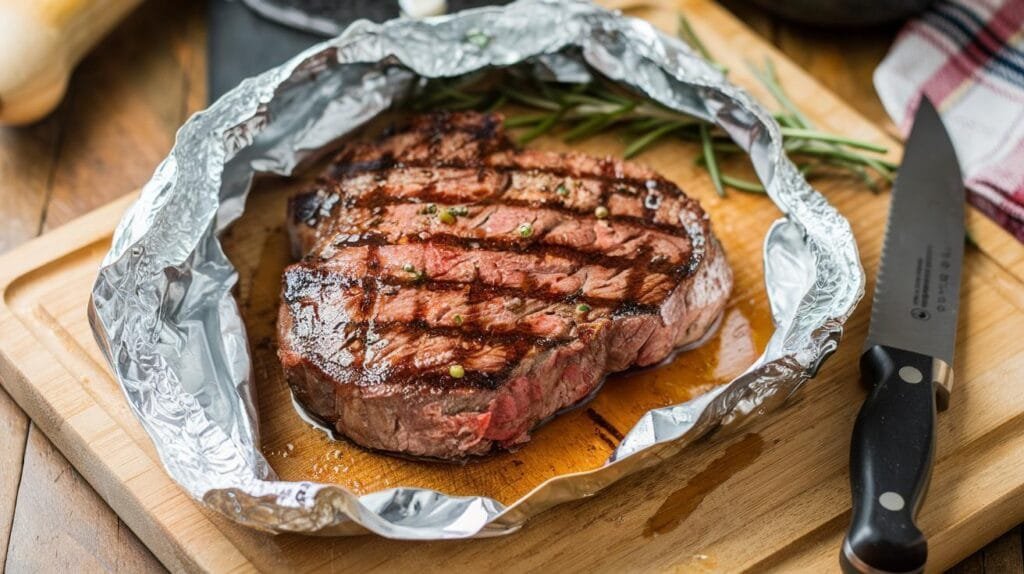
Give your cowboy steak 5–10 minutes to rest before slicing. This small step ensures that every forkful is as juicy and tender as possible. Plus, it gives you a moment to gather your sides and set the table for a picture-perfect presentation.
Why Are Cowboy Steaks So Tender?
Ever wonder why cowboy steaks have that signature buttery texture? It’s all about the marbling, aging, and, yes, a little bit of culinary magic. Let’s break down what makes this cut so irresistibly tender.
The Role of Marbling in Tenderness
Marbling is the steak’s best friend. Those white streaks of fat running through the meat aren’t just for show—they’re the secret to its tenderness. As the steak cooks, the fat melts, basting the meat from the inside out. This creates that melt-in-your-mouth experience that makes cowboy steaks stand out from other cuts.
And here’s the kicker: the better the marbling, the better the steak. That’s why USDA Prime or Choice grades are worth seeking out. These grades ensure that the meat has the perfect balance of fat and lean for optimal tenderness.
Aging Process: Dry-Aged vs Wet-Aged Cowboy Steaks
Another factor that impacts tenderness is the aging process. Dry-aged cowboy steaks are aged in a controlled environment, allowing natural enzymes to break down the muscle fibers. This results in a steak that’s incredibly tender with a concentrated beefy flavor. Think of it like letting fine wine mature—it only gets better with time.
Wet-aged steaks, on the other hand, are vacuum-sealed and aged in their own juices. While they’re slightly less tender than their dry-aged counterparts, they’re still a fantastic option for anyone craving a juicy steak. Both methods deliver great results, so it really comes down to personal preference.
The Cowboy Steak Recipe
When it’s time to showcase your cowboy steak skills, having a foolproof recipe in your back pocket is key. This classic cowboy steak recipe highlights the cut’s natural flavors while adding a touch of smoky, savory goodness.
Classic Cowboy Steak Marinade Recipe
A good marinade can elevate your cowboy steak from delicious to unforgettable. Here’s a tried-and-true recipe:
Ingredients:
- 1/4 cup olive oil
- 2 tablespoons balsamic vinegar
- 3 cloves garlic, minced
- 1 teaspoon rosemary, chopped
- 1 teaspoon thyme, chopped
- 1 teaspoon kosher salt
- 1/2 teaspoon freshly cracked black pepper
Instructions:
- Combine all the ingredients in a bowl and whisk together.
- Place the cowboy steak in a resealable plastic bag or a shallow dish. Pour the marinade over the steak, ensuring it’s fully coated.
- Marinate in the fridge for at least 2 hours, or overnight for maximum flavor.
When ready to cook, remove the steak from the marinade, pat it dry, and follow your preferred cooking method. The result? A steak that’s bursting with flavor in every bite.
How to Serve Cowboy Steaks Like a Pro
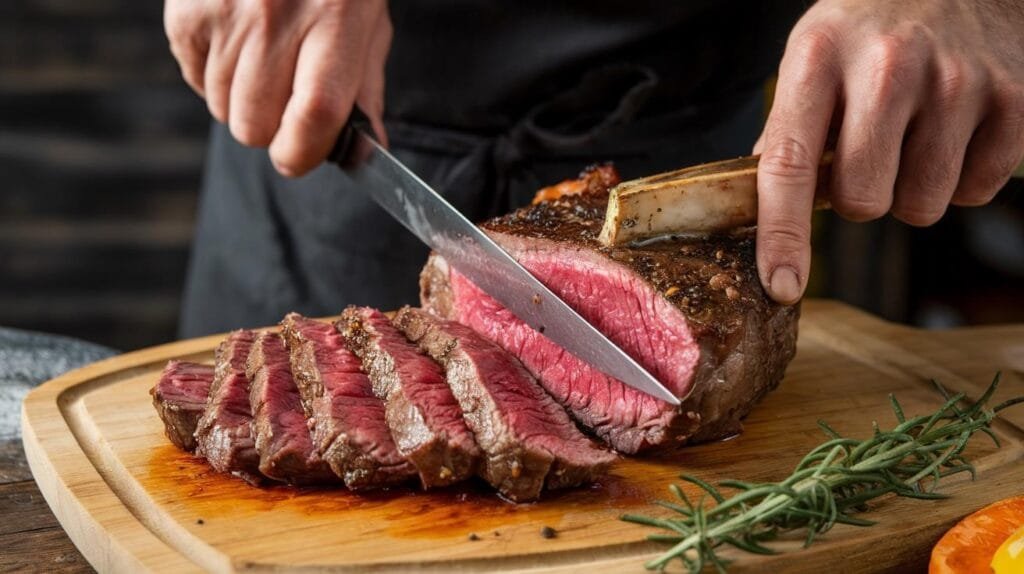
Presentation matters, especially with a showstopping cut like the cowboy steak. For the perfect presentation:
- Slice the steak against the grain into thick, juicy pieces. This helps keep the meat tender and easy to chew.
- Arrange the slices on a platter with the bone in the center for a dramatic effect.
- Garnish with fresh herbs, such as parsley or rosemary, for a pop of color.
Pair the steak with classic sides like roasted garlic mashed potatoes, grilled asparagus, or a fresh arugula salad. Want to impress even more? Serve with a drizzle of chimichurri or a dollop of garlic herb butter on top.
Cowboy Steak Price: What to Expect
If you’ve shopped for cowboy steaks before, you’ve probably noticed the hefty price tag. So, why are they so expensive? Let’s break it down.
Why Is Cowboy Steak So Expensive?
The cowboy steak’s cost comes down to three factors: size, quality, and demand. This cut is large, luxurious, and packed with flavor—qualities that don’t come cheap. Additionally, the bone-in presentation adds weight, which contributes to the price.
But here’s the thing: while cowboy steaks may be pricey, they’re worth every penny. You’re not just paying for a piece of meat—you’re investing in an unforgettable dining experience. Whether it’s a special occasion or a treat-yourself moment, the cowboy steak delivers.
Are Cowboy Steaks Worth the Price?
In a word: absolutely. When you consider the flavor, tenderness, and visual impact, cowboy steaks are a true indulgence. Plus, their versatility means you can enjoy them grilled, roasted, or pan-seared, making them a versatile addition to any recipe repertoire.
Where to Buy Cowboy Steaks Near Me
When it comes to finding a high-quality cowboy steak, knowing where to shop is half the battle. While not every grocery store will carry this premium cut, there are plenty of reliable options for sourcing the perfect cowboy steak. Whether you prefer shopping locally or browsing online, let’s explore the best places to score this impressive cut.
Online Meat Retailers Offering Cowboy Steaks
In the age of online shopping, buying premium cuts like cowboy steak has never been easier. Many online meat retailers specialize in high-quality beef and offer delivery straight to your doorstep. Here are a few popular options to consider:
- Omaha Steaks: A household name for premium meats, Omaha Steaks offers expertly trimmed cowboy steaks with reliable shipping and great customer service.
- Snake River Farms: Known for their American Wagyu beef, Snake River Farms provides cowboy steaks that are rich, tender, and packed with flavor.
- Porter Road: If you’re looking for pasture-raised, sustainably sourced cowboy steaks, Porter Road is an excellent choice. Their commitment to quality shines through in every bite.
Ordering online allows you to compare options, select your desired grade (Prime, Choice, etc.), and read reviews to ensure satisfaction. Plus, the convenience of doorstep delivery makes it a hassle-free experience.
Local Butchers and Specialty Stores
If you prefer a hands-on approach, visiting your local butcher or specialty meat market is a fantastic option. Butchers often offer personalized service and can cut the steak to your preferred thickness. Here’s how to make the most of your butcher shop visit:
- Ask for Recommendations: Don’t hesitate to chat with the butcher. They can recommend the best cuts, share tips on preparation, and even help you choose a marinade.
- Inspect the Meat: Look for bright red beef with even marbling. A fresh cowboy steak will be firm to the touch and have a mild, pleasant smell.
- Support Local: Purchasing from a local butcher not only ensures freshness but also supports small businesses in your community.
Specialty grocery stores, such as Whole Foods or local co-ops, often carry premium cuts like cowboy steaks. Keep an eye out for sales or promotions to snag a great deal.
Cowboy Steak Pairings: What Goes Best with It?
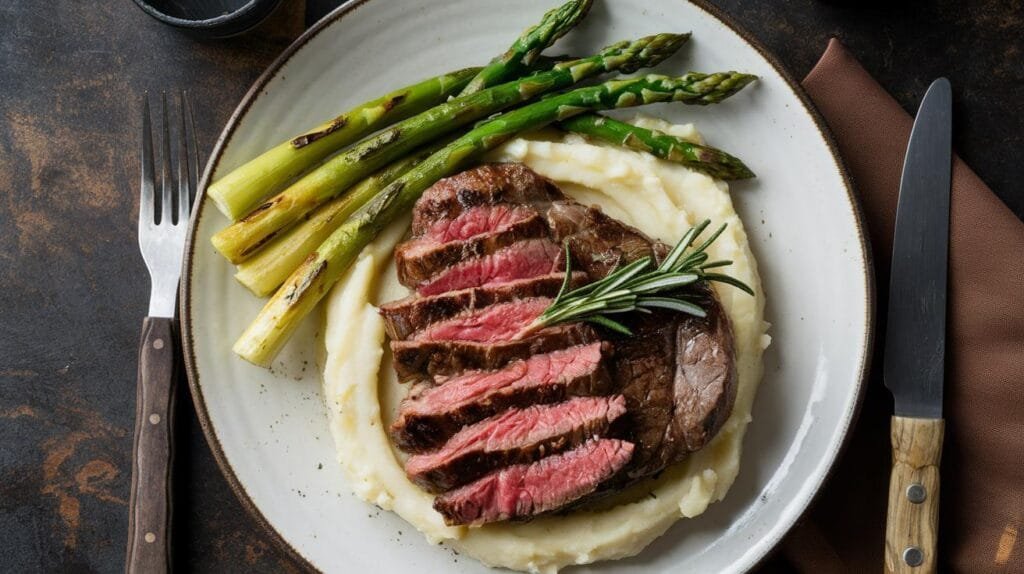
A cowboy steak is a meal on its own, but the right pairings can take your dining experience to a whole new level. Whether you’re hosting a dinner party or enjoying a quiet night in, these side dishes and drinks are the perfect complements to your cowboy steak.
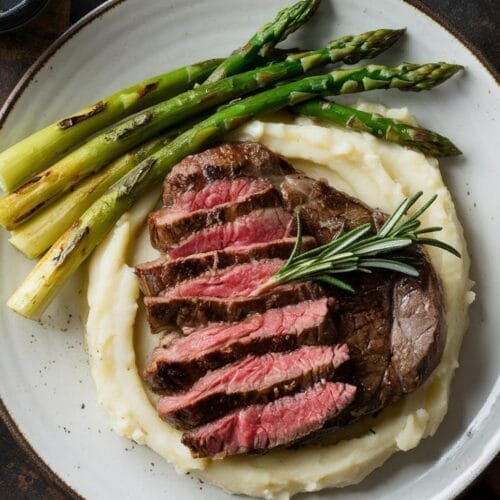
Cowboy steak with creamy mashed potatoes
Ingredients
- - 1 large cowboy steak ribeye, bone-in
- - 2 cups mashed potatoes
- - 1 bunch asparagus
- - 2 tbsp olive oil
- - 2 cloves garlic minced
- - 1 tbsp fresh rosemary
- - Salt and pepper to taste
- - 2 tbsp unsalted butter
- - 1 tbsp cream for mashed potatoes
Instructions
- 1. Preheat grill or stovetop skillet to medium-high heat.
- 2. Season the steak generously with salt, pepper, and rosemary.
- 3. Heat olive oil in a skillet; sear the steak on each side for 4-5 minutes.
- 4. Transfer the steak to a preheated oven at 400°F for 6-8 minutes for medium-rare.
- 5. Boil asparagus for 2 minutes, then grill for 3 minutes with olive oil and garlic.
- 6. Prepare mashed potatoes: Mash boiled potatoes with butter, cream, and a pinch of salt.
- 7. Rest the steak for 5 minutes before slicing. Serve with sides.
Notes
- Use Yukon gold potatoes for creamier mashed potatoes.
- Pair with red wine for an elevated experience.
Best Side Dishes for Cowboy Steaks
The richness of a cowboy steak pairs beautifully with a variety of sides, especially those that balance its bold flavor. Here are some classic and creative ideas:
- Roasted Garlic Mashed Potatoes: Creamy, buttery mashed potatoes are a timeless steakhouse side. Add roasted garlic for an extra layer of flavor.
- Grilled Vegetables: Asparagus, zucchini, and bell peppers grilled to perfection provide a fresh, smoky contrast to the steak.
- Creamed Spinach: A rich and velvety side dish that’s a match made in heaven for a hearty cowboy steak.
- Corn on the Cob: Charred corn with a sprinkle of chili lime seasoning adds a sweet and tangy element to your plate.
- Herbed Rice Pilaf: Light, fluffy, and infused with fresh herbs, rice pilaf is a versatile and satisfying accompaniment.
Recommended Wines and Beverages to Complement the Flavor
Pairing the right drink with a cowboy steak can enhance its natural flavors and elevate the entire meal. Here are some suggestions:
- Red Wine: Full-bodied reds like Cabernet Sauvignon, Malbec, or Syrah are classic choices for a cowboy steak. Their bold flavors stand up to the richness of the beef.
- Craft Beer: A dark stout or a malty amber ale complements the smoky, charred notes of the steak beautifully.
- Whiskey or Bourbon: For a bold pairing, a sip of aged whiskey or bourbon adds a hint of smokiness and sweetness that mirrors the flavors of a grilled steak.
- Sparkling Water with Citrus: If you’re skipping alcohol, a refreshing sparkling water infused with lemon or lime cleanses the palate and balances the richness of the meat.
Cowboy Steaks in Popular Culture
Cowboy steaks aren’t just beloved by chefs and home cooks—they’ve also carved out a special place in popular culture. From steakhouses to BBQ competitions, this iconic cut of beef continues to make headlines for its undeniable appeal.
Famous Restaurants Serving Cowboy Steaks
Across the United States, countless steakhouses have embraced the cowboy steak as a signature dish. Some of the most iconic destinations include:
- Del Frisco’s Double Eagle Steakhouse: Known for their luxurious dining experience, Del Frisco’s serves a mouthwatering bone-in ribeye that rivals the best cowboy steaks.
- Smith & Wollensky: This classic American steakhouse offers dry-aged cowboy steaks that are grilled to perfection.
- Peter Luger Steak House: A legendary name in New York City, Peter Luger serves premium cuts, including the cowboy steak, in a timeless setting.
These restaurants take pride in showcasing the cowboy steak’s natural flavors while adding their own unique twists. If you ever find yourself dining at one of these establishments, be sure to savor their expertly prepared cowboy steak.
The Appeal of Cowboy Steaks in BBQ Competitions
BBQ competitions across the country often feature cowboy steaks as a highlight of the event. The cut’s size, presentation, and flavor make it a standout choice for pitmasters looking to impress the judges. The key to winning with a cowboy steak? A perfect balance of seasoning, tenderness, and that signature smoky crust.
Many competitors use a reverse sear method, starting the steak low and slow on a smoker before finishing it over high heat for a caramelized crust. This technique highlights the cowboy steak’s versatility and reinforces its status as a champion-worthy cut.
Cowgirl Steak vs Cowboy Steak: What’s the Difference?
If you’ve come across the term “cowgirl steak,” you might be wondering how it differs from a cowboy steak. While both cuts are similar in flavor and tenderness, the cowgirl steak is slightly smaller and has less bone. It’s essentially a trimmed-down version of the cowboy steak, designed for those who prefer a lighter portion without sacrificing flavor.
The cowgirl steak is ideal for smaller appetites or when you want a more elegant presentation. Think of it as the cowboy steak’s petite and equally delicious sibling.
FAQs
What cut of meat is cowboy steak?
A cowboy steak is a bone-in ribeye cut thick with part of the rib bone left attached. Its generous marbling and bold flavor make it a popular choice for grilling and roasting.
What’s the difference between a tomahawk and a cowboy steak?
The main difference lies in the bone length. A tomahawk steak has a long, Frenched bone for dramatic presentation, while a cowboy steak features a shorter rib bone that’s easier to cook and handle.
Why is cowboy steak so expensive?
Cowboy steaks are expensive due to their size, quality, and demand. The bone-in presentation adds weight, and the rich marbling enhances flavor, making it a premium cut.
Why are cowboy steaks so tender?
Cowboy steaks are tender thanks to their high marbling content, which melts during cooking and bastes the meat. Aging processes, such as dry or wet aging, also contribute to their tenderness.
Final Thoughts on Cooking the Perfect Cowboy Steak
Mastering the art of cooking a cowboy steak is both rewarding and delicious. This iconic cut, with its bold flavor, impressive presentation, and rich history, deserves a place on every steak lover’s plate. Whether grilled to perfection or roasted in the oven, the cowboy steak never fails to make a statement.
By following the tips and techniques outlined in this guide, you’ll be able to prepare a cowboy steak that rivals any steakhouse offering. So grab your apron, fire up the grill, and get ready to impress your family and friends with the ultimate steak experience. Bon appétit!
